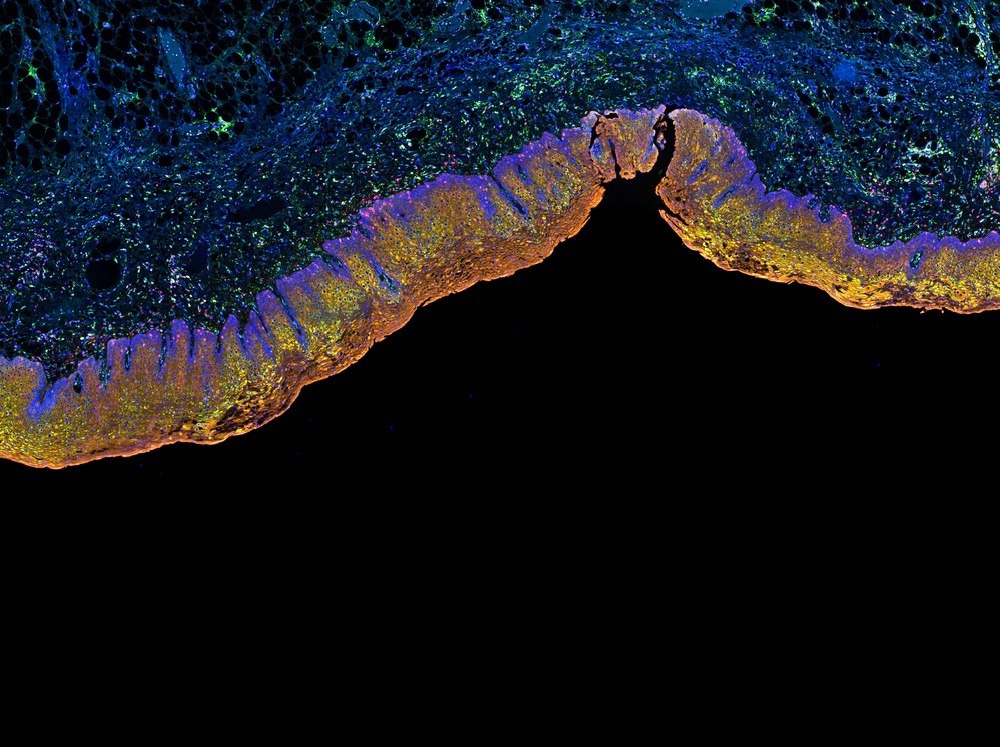Plasmonic nanoshells have been accepted as effective nanomaterials for LDI-MS recognition of many small molecules, although their uses in mass spectrometry imaging (MSI) are not much established. A study in the article ACS Applied Nano Materials reported the development and optimization of SiO2@Au nanoshells having custom shell compositions and structures for high-sensitivity LDI-MS analysis and a variety of MSI bases applications.

Study: Plasmonic Gold Nanoshell-Assisted Laser Desorption/Ionization Mass Spectrometry for Small-Biomolecule Analysis and Tissue Imaging. Image Credit: Carl Dupont/Shutterstock.com
Mass Spectrometry Imaging
Mass spectrometry imaging (MSI) has become a popular label-free method that allows the spatial clarity of a wide range of analytes, including drugs, lipids, peptides, small biomolecules, and proteins present in various intricate samples, like individual cells and biological tissues.
Due to its superior limit of detection (LOD), high productivity, high salt tolerance and minimal sample consumption, matrix-assisted laser desorption/ionization (MALDI) has emerged as one of the essential methods for MSI.
Disadvantages of MALDI
Despite being vastly used, the approach has a number of inherent drawbacks related to organic matrices, including poor spot-to-spot reproducibility, significant background interference ions in low mass areas, and occasionally reduced ion yield toward tiny molecules.
Due to heterogeneous cocrystallization, it is still difficult to implant a consistent film of organic matrices on tissue coating, which can lead to decreased tissue imaging resolution.
Recrystallization is essential for addressing the extraction of weak analytes to achieve good ionization yields, and great attention has been given to minimizing this phenomenon. Therefore, creating a matrix-free LDI technique with the combined benefits of improved tissue imaging capabilities and recognition sensitivity is particularly desirable regarding mapping the spatial distribution of small molecules.
Ultraviolet-Absorbing Inorganic Nanomaterials
Inorganic nanomaterials that absorb ultraviolet (UV) light, such as those based on silicon, carbon, composite nanomaterials, metal nanoparticles (NPs), metal oxide NPs, and metal-organic frameworks (MOFs), have drawn a lot of attention. These newly developed nanomaterials have advantages such as low thermal conductivity, excellent light absorption, high electrical conductivity, and high surface area to volume ratio.
Although nanomaterials' fine architectures vary, irrespective of spraying or sputtering, their nanosized characteristics often produce a homogenous coating surface, making them suitable candidates for MSI testing and tissue imaging.
Metal-Based Nanoparticles
An effective alternative for tracking endogenous metabolites present in animal and plant tissues is using metal oxide NPs. The high boiling and melting points of these NPs make them resistant to ionization, resulting in a clear mass spectrum with high limiting background signals.
Plasmonic Nanomaterials
To meet the growing demand for quick, targeted, and sensitive detection of small biomolecules, composite nanomaterials with synergistic action has attracted great attention. Plasmonic nanomaterials have been extensively researched for LDIMS and tissue imaging of different metabolites due to hot carrier characteristics and localized surface plasmon resonance (LSPR).
However, according to several studies, they possess problems such as inevitable aggregations and inadequate thermal conductivity. A continuous effort has been put into creating plasmonic core-shell nanoparticles for sensitive analysis of metabolites in a variety of biological samples to address these limitations.
Silicon-Based Nanomaterials
For effective LDI-MS for metabolites present in human bio-fluid samples, a variety of nanoshells based on silica core have been presented. To provide distinctive metabolic fingerprinting, a number of plasmonic bimetallic/trimetallic alloys have also been produced. Despite significant efforts, plasmonic core–shell nanoparticles' excellent performance and a high potential for LDI–MS and tissue imaging in practical implementations are not at all optimal.
In this work, a number of SiO2@Au core−shell NPs having controllable nanoshell frameworks were achieved through a multi-cycled reduction reaction of Au3+ ions with the film of SiO2 spheres. The production procedure is straightforward, repeatable, and minimally reactive.
The SiO2@Au nanoshells show improved performance in the evaluation of numerous small compounds with significantly less background interference, as compared to typical organic matrices, owing to enhanced photoelectric effects, hot carrier generation and local heating.
Important Findings
Three things could explain why these plasmonic gold nanoshells have better tissue imaging characteristics than currently present nanomaterials with a single composition. Firstly, SiO2@Au nanoshells have significantly high light-to-heat conversion efficiency. Secondly, roughness of nanoscale provides a particular crevice area for the specific trapping of cations and small molecules from intricate biological mixtures. Finally, the negatively charged layer encourages the creation of a layer of cations during the ionization procedure. All of these factors contribute to a high ion yield.
Small molecule lipid species and metabolites can be spatially observed in strawberry tissues, mouse brain tissues and the whole-body tissues of honeybees and zebrafish due to the nanoscale size and homogenous layering of SiO2@Au nanoshells. These concrete evidence show that plasmonic-based nano shell materials' capabilities can be enhanced for use in practical MSI applications.
Reference
Du, M., Chen, D. et al. (2022). Plasmonic Gold Nanoshell-Assisted Laser Desorption/Ionization Mass Spectrometry (LDI-MS) for Small-Biomolecule Analysis and Tissue Imaging. Available at: https://doi.org/10.1021/acsanm.2c01850
Disclaimer: The views expressed here are those of the author expressed in their private capacity and do not necessarily represent the views of AZoM.com Limited T/A AZoNetwork the owner and operator of this website. This disclaimer forms part of the Terms and conditions of use of this website.